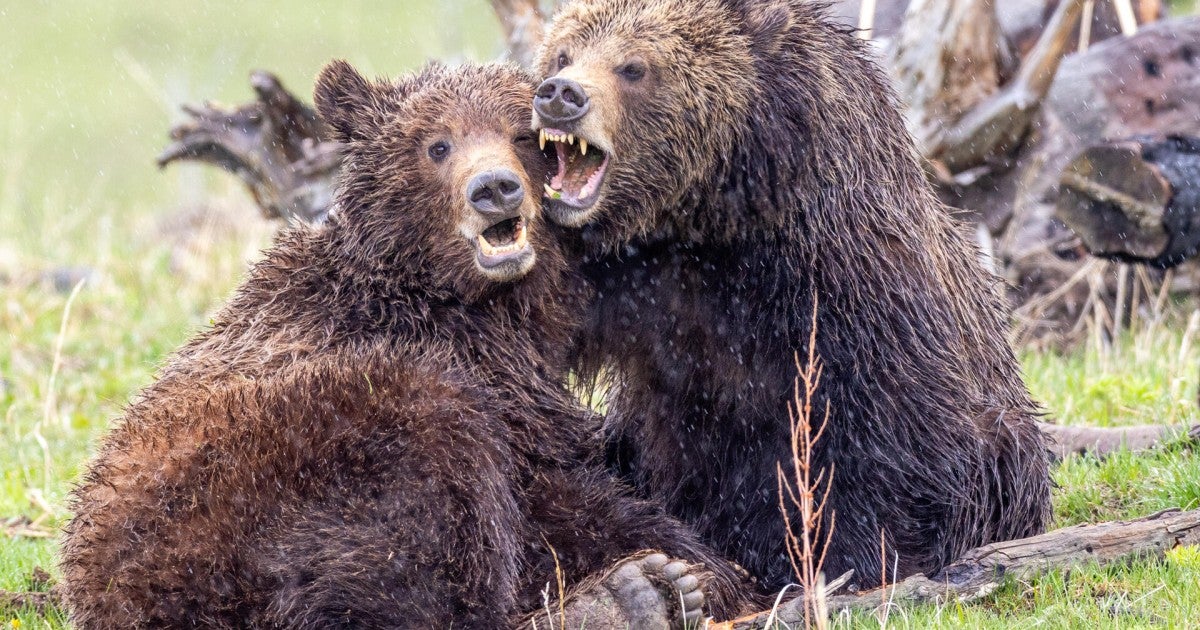Americans love grizzly bears—so why do elected officials keep failing to protect them? – Humane World for Animals

Analysis of Threats to Grizzly Bear Populations and Alignment with Sustainable Development Goals
Introduction: Conservation Challenges and the SDG Framework
The conservation of grizzly bear populations in the United States faces significant legislative, policy, and management challenges. These threats directly contravene key targets within the United Nations Sustainable Development Goals (SDGs), particularly SDG 15 (Life on Land), which aims to halt biodiversity loss. Furthermore, the issue intersects with SDG 8 (Decent Work and Economic Growth), SDG 11 (Sustainable Cities and Communities), SDG 12 (Responsible Consumption and Production), and SDG 16 (Peace, Justice and Strong Institutions), highlighting the interconnectedness of biodiversity conservation with sustainable economic and social development.
Current Threats to Grizzly Bear Conservation and SDG 15
Recent developments pose a direct threat to the long-term viability of grizzly bear populations, undermining efforts to protect terrestrial ecosystems and halt the loss of biodiversity as mandated by SDG 15.
Legislative and Policy Pressures
Several legislative and administrative actions are underway that could remove federal protections for grizzly bears:
- Proposed Delisting Legislation: The Grizzly Bear State Management Act (H.R. 281) and a policy rider in the FY26 House Interior bill (H.R. 4754) seek to delist the Greater Yellowstone Ecosystem (GYE) grizzly bear population from the Endangered Species Act (ESA). A provision to block judicial review of this action undermines SDG 16 by limiting public access to justice and institutional accountability.
- Increased Lethal Management: A proposed rule from the U.S. Fish and Wildlife Service (USFWS) would grant increased flexibility for killing grizzly bears in the GYE and Northern Continental Divide ecosystems, even while maintaining their ESA status.
- Transfer of Management Authority: The USFWS has indicated that transferring management authority from the federal government to individual states is a priority, signaling a potential move towards widespread delisting and state-sanctioned trophy hunting.
Human-Wildlife Conflict and Mortality Data
Mortality rates for grizzly bears, particularly in the Yellowstone area, have reached record levels, directly impacting population stability and biodiversity targets under SDG 15.
- Record Mortality: As of September 22, 2025, at least 63 bears were killed in the GYE, marking the second consecutive year of record-breaking numbers.
- Causes of Death: Analysis of the 63 known mortalities reveals that conflicts are primarily human-driven.
- 28% were killed in response to livestock depredation. This occurs despite data showing that all carnivores combined are responsible for less than 1% of cattle and sheep losses.
- 19% were killed as perceived threats in human-dominated areas.
- 12% (eight individuals) were adult females, a significant loss for the population’s reproductive capacity.
Socio-Economic Dimensions and Sustainable Development
The protection of grizzly bears is intrinsically linked to the economic and social well-being of local communities, aligning with multiple SDGs.
Economic Contributions and SDG 8
Grizzly bears are a significant driver of sustainable tourism, contributing to local economic growth and decent work (SDG 8).
- A National Park Service analysis values grizzly bear sightings in Yellowstone at $6.9 million annually.
- Each individual grizzly bear is estimated to contribute $46,000 per year to regional economies.
- Total tourism spending in the Yellowstone and Glacier National Park regions amounted to $5.28 billion across 2023 and 2024.
Permitting trophy hunting could jeopardize this nature-based economic model, replacing a sustainable, non-consumptive industry with a practice that diminishes the ecological and economic asset.
Promoting Coexistence: Aligning with SDG 11 and SDG 12
Lethal management is an ineffective long-term solution to human-wildlife conflict. A transition to non-lethal coexistence strategies aligns with the goals of creating sustainable communities (SDG 11) and ensuring responsible production patterns (SDG 12).
- Conflict Prevention Tools: Proven methods include removing attractants, using bear-proof waste containers, deploying electric fencing for livestock, and carrying bear spray in recreational areas.
- Sustainable Agriculture: Promoting ranching practices that integrate non-lethal deterrents supports responsible production (SDG 12) by minimizing negative impacts on local biodiversity.
Conclusion: The Imperative for SDG-Aligned Conservation
Current legislative and policy trends threaten to reverse decades of conservation success for grizzly bears. These actions are inconsistent with the United States’ commitment to the Sustainable Development Goals. Delisting the species, particularly without judicial oversight, undermines SDG 16 (Peace, Justice and Strong Institutions). Failing to protect grizzly populations is a direct failure to meet the targets of SDG 15 (Life on Land). Furthermore, ignoring the significant economic contributions of grizzlies to sustainable tourism runs counter to the principles of SDG 8 (Decent Work and Economic Growth). A comprehensive conservation strategy must prioritize non-lethal conflict mitigation and recognize the species’ ecological and economic value to ensure a sustainable future for both wildlife and human communities.
Analysis of Sustainable Development Goals in the Article
1. Which SDGs are addressed or connected to the issues highlighted in the article?
The article primarily addresses issues related to two Sustainable Development Goals (SDGs):
- SDG 15: Life on Land: This is the most prominent SDG in the article. The entire text focuses on the protection of grizzly bears, a terrestrial species, from threats such as legislative delisting from the Endangered Species Act, increased killings by ranchers and state agents, and the potential for trophy hunting. The goal is to protect, restore, and promote sustainable use of terrestrial ecosystems, sustainably manage forests, combat desertification, and halt and reverse land degradation and halt biodiversity loss. The fight to protect grizzly bears from extinction is a direct reflection of this goal.
- SDG 8: Decent Work and Economic Growth: The article connects the protection of grizzly bears to economic benefits, specifically through tourism. It highlights the significant revenue generated by wildlife viewing in the Yellowstone area. This links conservation efforts to the promotion of sustainable tourism, which is a component of sustainable economic growth.
2. What specific targets under those SDGs can be identified based on the article’s content?
Based on the article’s content, the following specific targets can be identified:
- Target 15.5: “Take urgent and significant action to reduce the degradation of natural habitats, halt the loss of biodiversity and, by 2020, protect and prevent the extinction of threatened species.”
- The article is centered on preventing the extinction of grizzly bears, which are described as a threatened species. It details legislative and policy threats (H.R. 281, H.R. 4754) that could lead to delisting them from federal protection, which would increase their vulnerability and risk of extinction. The call to “work together to protect grizzly bears from extinction” directly aligns with this target.
- Target 15.7: “Take urgent action to end poaching and trafficking of protected species of flora and fauna and address both demand and supply of illegal wildlife products.”
- While the article discusses legally sanctioned killing rather than illegal poaching, the principle is the same: taking urgent action to end the killing of a protected species. The article highlights that “ranchers and state and federal agents killed Yellowstone-area grizzly bears in record numbers.” The push against delisting and trophy hunting is an effort to stop the killing of this protected animal, which is the essence of this target.
- Target 8.9: “By 2030, devise and implement policies to promote sustainable tourism that creates jobs and promotes local culture and products.”
- The article explicitly argues for the protection of grizzly bears by citing their economic value to tourism. It states that “grizzly bear sightings are valued at $6.9 million annually” and that tourists in the Yellowstone area spend billions. Protecting the bears is presented as a policy for sustaining this form of tourism, which supports local economies, directly linking to the goal of promoting sustainable tourism.
3. Are there any indicators mentioned or implied in the article that can be used to measure progress towards the identified targets?
Yes, the article mentions several quantitative and qualitative indicators that can be used to measure progress:
- Number of threatened species killed: The article provides a direct indicator for Target 15.5 by stating, “at least 63 bears were killed in 2025.” Tracking this number annually would measure the direct threat level to the species. The breakdown of causes (e.g., “28% of bears were killed to ‘protect’ farm animals”) provides further detail.
- Legal and policy status of protected species: The status of legislation like the “Grizzly Bear State Management Act (H.R. 281)” and the species’ listing under the “Endangered Species Act” are key indicators. Progress would be measured by the defeat of delisting efforts and the strengthening of protective policies.
- Economic value derived from sustainable tourism: For Target 8.9, the article provides specific economic indicators. These include the annual value of grizzly bear sightings (“$6.9 million annually”), the economic contribution per bear (“$46,000 per year”), and the total tourist spending in the region (“$5.28 billion”). These figures can be used to track the economic contribution of wildlife and measure the success of sustainable tourism policies centered on conservation.
Summary Table of SDGs, Targets, and Indicators
| SDGs | Targets | Indicators |
|---|---|---|
| SDG 15: Life on Land | 15.5: Protect and prevent the extinction of threatened species. |
|
| SDG 15: Life on Land | 15.7: Take urgent action to end poaching and trafficking of protected species. |
|
| SDG 8: Decent Work and Economic Growth | 8.9: Devise and implement policies to promote sustainable tourism. |
|
Source: humaneworld.org
What is Your Reaction?
 Like
0
Like
0
 Dislike
0
Dislike
0
 Love
0
Love
0
 Funny
0
Funny
0
 Angry
0
Angry
0
 Sad
0
Sad
0
 Wow
0
Wow
0
















































:focal(1500,1000)/https://media.globalcitizen.org/a6/9a/a69a4720-d8a1-4715-b596-18738d03c05c/rotary_polio_hero_image.jpg?#)







/countries/sri-lanka/photo-credit---dmc-sri-lanka.tmb-1200v.jpg?sfvrsn=dc298bcc_1#)

















